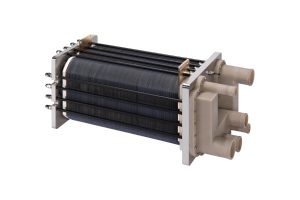“Safety is of the utmost importance in all use and storage of hydrogen. If leaks are detected early, they can be fixed so that you hopefully do not have to take the plant or vehicle out of service at all,” said Chalmers Professor Christoph Langhammer, one of the main authors of the scientific article detailing the research findings. The article has been published in Nature Communications.
The optical hydrogen sensor consists of many metal nanoparticles that work together to detect hydrogen in their surroundings. The approach to how the new sensor was designed differs from what has been done previously. Instead of producing a large number of samples and testing them individually to see which one works best, the researchers have used advanced AI technology to create the optimal interaction between the particles based on their distance to each other, diameter and thickness. The result is a sensor that detects changes in hydrogen concentration that are as small as a few hundred thousandths of a percent.
The secret behind the new sensor’s low detection limit is the combination of the arrangement of the particles in a regular pattern on a surface and their fine-tuned dimensions. This turned out to be more favourable for the sensitivity of the sensor than the random particle arrangement used in previous sensors of the same type.
According to Professor Langhammer, “the technology around hydrogen has taken a giant leap and therefore today’s sensors need to be more accurate and tailored for different purposes. Sometimes a very fast sensor is needed, sometimes one is needed that works in a harsh chemical environment or at low temperatures. A single sensor design cannot meet all needs.”
How the optical H₂ sensor works
- The sensor that the researchers have developed is based on an optical phenomenon, plasmons, which occur when metal nanoparticles capture light and give the particles a distinct colour. If the nanoparticles are made of palladium or a palladium alloy, their colour changes when the amount of hydrogen in the surroundings varies, and the sensor can trigger an alarm if the levels become critical.
- To find the ultimate combination of the arrangement on the surface and geometry of the particles in the sensor, the researchers used an artificial intelligence algorithm called particle swarm optimisation to achieve the highest possible sensitivity to the exposure to hydrogen. Placing the particles in a very precisely defined regular pattern turned out to be the answer.
- Based on the AI-design, the optimised optical hydrogen sensor was fabricated and verified to be the first of its kind to optically detect hydrogen in the ‘parts per billion’ range (250 ppb).
The new sensor’s practical applicability will now be further investigated within the newly started competence centre TechForH2, which is coordinated by Chalmers University of Technology.






